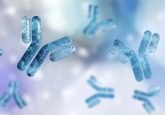Systematic investigation of orthogonal SPE sample preparation for the LC–MS/MS bioanalysis of a monoclonal antibody after pellet digestion

Access to this article is provided courtesy of AB SCIEX.
Background: Increasing assay sensitivity is critical for promoting the application of LC–MS/MS quantitative bioanalysis of therapeutic proteins. A sample processing method that can selectively remove the abundant background peptides in the serum tryptic digests and retain the target peptides can greatly improve the assay sensitivity. Results: Mixed-mode strong-cation exchange SPE was systematically investigated as an orthogonal sample separation technique to reversed-phase UHPLC for the analysis of a test monoclonal antibody, BMS-986012, in monkey serum after pellet digestion. Strong cation exchange SPE efficiently removed most of the background peptides and reduced the matrix effect and background level in the monitored mass transition channels. As a result, improved sensitivity was observed for the surrogate peptides VVSV and SLIY. Conclusion: This orthogonal approach provides a simple and easy-to-develop sample preparation method that can selectively remove most background peptides and extract the target peptides, therefore, improving the LC–MS/MS assay sensitivity.
The therapeutic use of proteins, native or recombinant, has increased remarkably over the past few decades. Monoclonal antibody (mAb) drugs are the fastest growing class of protein therapeutics with at least 29 approved drugs; with more than 500 under development [1]. Ligand-binding assays are the gold standard for the quantitative analysis of protein therapeutics in biological matrices. Ligand-binding assays can often provide highly sensitive analysis of proteins in the concentration level of low ng/ml to pg/ml [2,3]. Recently, LC–MS/MS has been gaining greater attention and interest as an alternative technology for the quantitative bioanalysis of therapeutic proteins [4–14]. LC–MS/MS-based methods have unique advantages in high specificity, fast and cost-efficient method development, wide linear dynamic range, and ability to quantify multiple proteins simultaneously. However, it is very difficult for LC–MS/MS assays to achieve the same high sensitivity as ligand-binding assays, and their sensitivity are usually at the low µg/ml level. The benefits and limitations of LC–MS/MS assays have been extensively reviewed [2.3.15–17].
Click here to view the full article.






